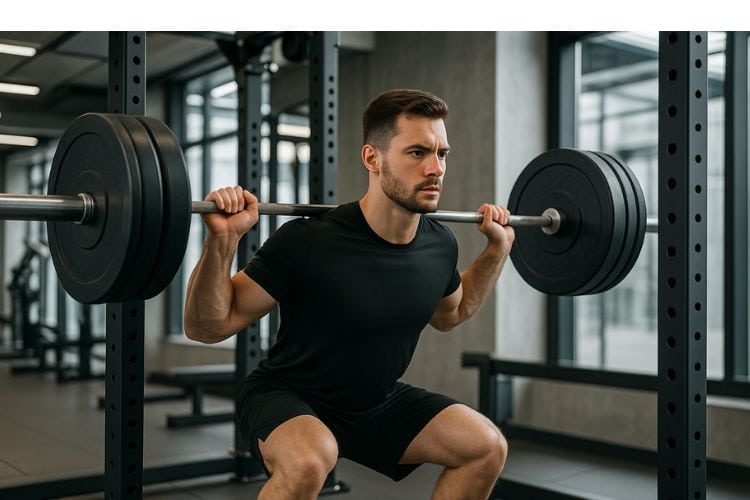
45-Minute Powerlifting Workout Plan for Strength & Muscle Growth

5-Day Powerlifting Workout Routine: for Strength & Muscle-Building

20-Minute Lower Body Workout Plan – Build Strong Legs Fast

20-Minute Full Body Barbell Workout Power Strength Routine
Best Compound Lifts for Men Over 40 to Build Strength

Staying strong and athletic after 40 isn’t just about lifting heavier — it’s about training smarter. Compound lifts are among the most effective exercises men over 40 can do to preserve lean muscle, improve joint health, and maintain testosterone levels naturally. These multi-joint movements not only torch calories but also build functional strength that keeps you performing at your best in the gym and in everyday life.
In this comprehensive guide, we’ll break down what compound lifts are, why they matter more than ever for men over 40, how to perform them safely, and how to build a balanced weekly training routine around them.
What Are Compound Lifts?
Compound lifts are multi-joint movements that engage multiple muscle groups at once. Unlike isolation exercises (like bicep curls or leg extensions) that target one muscle, compound exercises train large areas of the body simultaneously — giving you more strength, coordination, and calorie burn per rep.
Common examples include:
- Squats – work quads, hamstrings, glutes, and core
- Deadlifts – strengthen back, legs, grip, and core
- Bench Press – targets chest, shoulders, and triceps
- Pull-Ups/Rows – hit the lats, biceps, and rear delts
- Overhead Press – builds shoulders, triceps, and upper chest
These exercises mirror real-life movement patterns — standing, pushing, pulling, and lifting — which makes them ideal for improving overall athletic performance and longevity.
Why Compound Lifts Matter for Men Over 40
After 40, men experience a gradual decline in testosterone, muscle mass, and recovery rate. The key to counteracting these changes is to train in a way that maximizes muscle recruitment and stimulates natural hormone production. Compound lifts do exactly that.
1. Maximized Hormonal Response
Heavy compound movements like squats and deadlifts stimulate the greatest release of testosterone and growth hormone, helping maintain lean muscle and combat age-related muscle loss (sarcopenia).
2. Time-Efficient Workouts
Men over 40 often juggle work, family, and recovery demands. Compound lifts allow you to train multiple muscle groups in less time — meaning you can get a full-body stimulus in under 45 minutes.
3. Improved Joint and Core Stability
These movements strengthen stabilizer muscles, tendons, and ligaments — key for long-term joint health. A strong core and stable joints reduce the risk of injury and make daily activities easier.
4. Increased Calorie Burn and Fat Loss
Because compound lifts engage several large muscles, they create a higher metabolic demand, which leads to more calories burned both during and after the workout — ideal for men fighting stubborn belly fat.
5. Functional Strength for Everyday Life
Whether lifting your kids, doing yard work, or playing weekend sports, the strength you gain from compound exercises translates directly to better real-world movement.
Top Compound Lifts for Men Over 40

Let’s dive into the most beneficial compound lifts for men in their 40s and how to perform them safely and effectively.
1. Barbell Squat
Primary Muscles: Quads, glutes, hamstrings, core
Why It’s Essential: Squats are the king of lower-body exercises. They build strength in the legs, enhance core stability, and support testosterone production.
Form Tips:
- Keep your chest tall and core tight.
- Sit back as if lowering into a chair.
- Push through the heels and avoid letting knees cave in.
- Start with goblet or bodyweight squats before progressing to a barbell.
Over 40 Tip: Focus on mobility and controlled tempo. Warm up hips and ankles before squatting to prevent knee or lower-back strain.
2. Deadlift
Primary Muscles: Glutes, hamstrings, lower back, traps, core
Why It’s Essential: The deadlift is a total-body powerhouse. It develops posterior-chain strength (the muscles along your back side), which improves posture and athletic power.
Form Tips:
- Keep bar close to your shins, chest up, and back flat.
- Drive through your heels and squeeze glutes at the top.
- Avoid rounding your back.
- Use moderate loads and perfect your form before lifting heavy.
Over 40 Tip: Consider the trap-bar deadlift — it reduces stress on the spine while still activating major muscle groups.
3. Bench Press Compound Lifts
Primary Muscles: Chest, triceps, shoulders
Why It’s Essential: A classic upper-body lift that builds pushing strength, chest density, and shoulder stability.
Form Tips:
- Keep feet flat and shoulder blades retracted.
- Lower the bar slowly to mid-chest.
- Push up without locking out elbows fully.
- Maintain a neutral wrist position to protect joints.
Over 40 Tip: Alternate with dumbbell bench press to improve shoulder mobility and reduce joint stress.
4. Pull-Ups or Lat Pulldowns
Primary Muscles: Lats, biceps, rear delts, traps
Why It’s Essential: Pulling strength balances pressing movements and builds width through the upper back, improving posture.
Form Tips:
- Engage your core, avoid swinging.
- Pull chest to bar and squeeze shoulder blades together.
- Lower under control.
Over 40 Tip: If bodyweight pull-ups are challenging, use assisted pull-up machines or resistance bands to build strength progressively.
5. Overhead Press (Standing or Seated) Compound Lifts
Primary Muscles: Deltoids, triceps, upper chest, core
Why It’s Essential: Builds shoulder strength and stability, helping maintain upper-body function and aesthetics.
Form Tips:
- Keep core tight and avoid leaning back.
- Lower bar or dumbbells to chin level and press overhead smoothly.
- Focus on range of motion without joint discomfort.
Over 40 Tip: Warm up rotator cuffs with light bands or external rotations before pressing to protect shoulder joints.
6. Bent-Over Row Compound Lifts
Primary Muscles: Lats, traps, rhomboids, posterior delts, biceps
Why It’s Essential: Strengthens the upper back and counteracts the effects of modern posture (rounded shoulders).
Form Tips:
- Keep a flat back and hinge at the hips.
- Pull bar or dumbbells toward your midsection.
- Squeeze shoulder blades at the top of each rep.
Over 40 Tip: Perform chest-supported rows if lower-back fatigue limits your form.
How to Structure a Compound Lift Routine for Men Over 40
When building your weekly training split, focus on balance, recovery, and progression. Here’s a sample plan integrating all major compound lifts while allowing adequate rest.
Sample 3-Day Full-Body Compound Lift Routine
Day 1 – Push Focus (Chest, Shoulders, Triceps)
- Warm-Up: 5–10 min mobility & dynamic stretching
- Barbell Bench Press – 4×8
- Overhead Press – 3×10
- Dumbbell Incline Press – 3×10
- Triceps Dips or Pushdowns – 3×12
- Core: Plank Hold – 3×45 sec
2 – Pull Focus (Back, Biceps, Rear Delts)
- Pull-Ups or Lat Pulldown – 4×8
- Bent-Over Rows – 4×10
- Seated Cable Row – 3×12
- Dumbbell Curls – 3×10
- Farmer’s Carry – 3 rounds of 30 sec
3 – Legs and Core
- Squats – 4×8
- Romanian Deadlift – 3×10
- Walking Lunges – 3×12 each leg
- Calf Raises – 3×15
- Core: Hanging Leg Raise – 3×12
Progression and Recovery
As a man over 40, your body may need more recovery time between heavy sessions. Focus on:
- Progressive overload: Increase weight gradually or add reps week to week.
- Active recovery: Light cardio or mobility work on rest days.
- Sleep and nutrition: Aim for 7–8 hours of rest and 1g of protein per pound of body weight daily.
- Deload weeks: Every 6–8 weeks, reduce intensity for a week to reset recovery and joint health.
Compound Lifts Mistakes Men Over 40 Should Avoid
1. Skipping Warm-Ups
Neglecting warm-ups is a recipe for joint strain. Spend at least 5–10 minutes on dynamic stretching and activation drills.
2. Training Too Heavy Too Often
Ego lifting leads to injuries. Focus on controlled movement, not maximal loads every week.
3. Ignoring Flexibility and Mobility
Tight hips, hamstrings, and shoulders can limit proper lifting form. Incorporate stretching, foam rolling, and mobility flows regularly.
4. Poor Recovery Habits
Skipping rest days or inadequate sleep sabotages progress. Recovery is where growth happens.
5. Neglecting Nutrition
Compound lifts burn calories and demand fuel. Without enough protein and quality carbs, your body can’t repair or grow muscle efficiently.
Best Recovery Practices for Men Over 40 Doing Compound Lifts
Building muscle and strength over 40 depends as much on recovery as it does on the workout itself.
Here’s how to optimize both:
1. Prioritize Sleep
Growth hormone release peaks during deep sleep. Poor rest leads to fatigue, inflammation, and muscle loss.
2. Use Active Recovery Days
Light cardio (walking, cycling) or yoga improves circulation and reduces stiffness without overloading the joints.
3. Fuel Your Body Right
Include lean proteins (chicken, eggs, fish), complex carbs (quinoa, brown rice), and healthy fats (avocados, olive oil).
Hydrate well and consider supplements like omega-3s, vitamin D, and magnesium to support joint and muscle function.
4. Monitor Inflammation
Joint stiffness or chronic soreness may signal overtraining. Use ice, foam rolling, or anti-inflammatory foods (berries, turmeric, green tea) to help recovery.
Compound Lifts vs Isolation Exercises: What’s Better Over 40?
While isolation movements have their place, compound lifts deliver the most results for men over 40 who want strength, fat loss, and overall vitality.
| Goal | Compound Lifts | Isolation Exercises |
|---|---|---|
| Build Strength | High impact | Limited |
| Burn Fat | High calorie burn | Low |
| Save Time | Multiple muscles per move | One muscle per move |
| Prevent Injury | Strengthens stabilizers | Often neglects core |
| Muscle Definition | Full-body tone | Targeted shaping |
For best results, combine both: 80% compound work, 20% isolation for weak points or aesthetic goals (like biceps or calves).
Safety Tips: Protecting Joints and Preventing Injuries
- Always warm up with mobility drills.
- Maintain proper form and control the negative phase of each lift.
- Use joint-friendly alternatives when needed — e.g., trap bar deadlift, front squats, or incline press.
- Train core stability with planks, bird dogs, and Pallof presses.
- Don’t skip cool-downs — static stretches and foam rolling help preserve flexibility.
The Mindset of Strength After 40
Training after 40 isn’t about outlifting your younger self — it’s about longevity, balance, and health. Every compound lift you master is an investment in staying mobile, confident, and capable for decades to come.
The goal isn’t just to build muscle — it’s to build a body that performs: strong joints, solid posture, and high energy for your work, family, and passions.
Compound Lifts Are the Foundation of Men’s Fitness After 40
For men over 40, compound lifts are the single best investment for maintaining muscle, mobility, and masculinity.
They deliver total-body strength, promote hormonal balance, and improve metabolism — all while reducing the time needed in the gym.
Start with perfect form, respect recovery, and focus on consistency over intensity. A smart, progressive compound-lift program will keep you looking, feeling, and performing your best well into your 50s and beyond.
Most Recommended
Subscribe to our Newsletter
Stay up to date on the latest men’s health, fitness and lifestyle trends and tips.
About Us
Men’s Fit Club was started with the goal of empowering men to get the most out of their lives. This meant going beyond exercise and diet tips to really address the broad range of issues that men face on a daily basis – topics like recreation, finding love, sexual health and even sound fashion advice.
Quick Links
© COPYRIGHT MEN'S FIT CLUB 2025. All Rights Reserved

